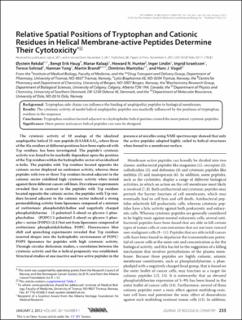| dc.contributor.author | Rekdal, Øystein | |
| dc.contributor.author | Haug, Bengt Erik | |
| dc.contributor.author | Kalaaji, manar | |
| dc.contributor.author | Hunter, Howard N. | |
| dc.contributor.author | Lindin, Inger | |
| dc.contributor.author | Israelsson, Ingrid | |
| dc.contributor.author | Solstad, Terese | |
| dc.contributor.author | Yang, Nannan | |
| dc.contributor.author | Brandl, Martin | |
| dc.contributor.author | Mantzilas, Dimitrios | |
| dc.contributor.author | Vogel, Hans J. | |
| dc.date.accessioned | 2022-05-05T06:47:52Z | |
| dc.date.available | 2022-05-05T06:47:52Z | |
| dc.date.created | 2011-12-14T09:34:40Z | |
| dc.date.issued | 2012 | |
| dc.identifier.issn | 0021-9258 | |
| dc.identifier.uri | https://hdl.handle.net/11250/2994261 | |
| dc.description.abstract | The cytotoxic activity of 10 analogs of the idealized amphipathic helical 21-mer peptide (KAAKKAA)3, where three of the Ala residues at different positions have been replaced with Trp residues, has been investigated. The peptide's cytotoxic activity was found to be markedly dependent upon the position of the Trp residues within the hydrophobic sector of an idealized α-helix. The peptides with Trp residues located opposite the cationic sector displayed no antitumor activity, whereas those peptides with two or three Trp residues located adjacent to the cationic sector exhibited high cytotoxic activity when tested against three different cancer cell lines. Dye release experiments revealed that in contrast to the peptides with Trp residues located opposite the cationic sector, the peptides with Trp residues located adjacent to the cationic sector induced a strong permeabilizing activity from liposomes composed of a mixture of zwitterionic phosphatidylcholine and negatively charged phosphatidylserine (1-palmitoyl-2-oleoyl-sn-glycero-3-phosphocholine (POPC)/1-palmitoyl-2-oleoyl-sn-glycero-3-phospho-l-serine (POPS)) (2:1) but not from liposomes composed of zwitterionic phosphatidylcholine, POPC. Fluorescence blue shift and quenching experiments revealed that Trp residues inserted deeper into the hydrophobic environment of POPC/POPS liposomes for peptides with high cytotoxic activity. Through circular dichroism studies, a correlation between the cytotoxic activity and the α-helical propensity was established. Structural studies of one inactive and two active peptides in the presence of micelles using NMR spectroscopy showed that only the active peptides adopted highly coiled to helical structures when bound to a membrane surface. | en_US |
| dc.language.iso | eng | en_US |
| dc.publisher | The American Society for Biochemistry and Molecular Biology | en_US |
| dc.rights | Navngivelse 4.0 Internasjonal | * |
| dc.rights.uri | http://creativecommons.org/licenses/by/4.0/deed.no | * |
| dc.title | Relative Spatial Positions of Tryptophan and Cationic Residues in Helical Membrane-active Peptides Determine Their Cytotoxicity | en_US |
| dc.type | Journal article | en_US |
| dc.type | Peer reviewed | en_US |
| dc.description.version | publishedVersion | en_US |
| dc.rights.holder | Copyright 2012 The American Society for Biochemistry and Molecular Biology | en_US |
| cristin.ispublished | true | |
| cristin.fulltext | original | |
| cristin.qualitycode | 2 | |
| dc.identifier.doi | 10.1074/jbc.M111.279281 | |
| dc.identifier.cristin | 867573 | |
| dc.source.journal | Journal of Biological Chemistry | en_US |
| dc.source.pagenumber | 233-244 | en_US |
| dc.subject.nsi | VDP::Medisinsk biokjemi: 726 | en_US |
| dc.subject.nsi | VDP::Medical biochemistry: 726 | en_US |
| dc.identifier.citation | Journal of Biological Chemistry. 2012, 287 (1), 233-244. | en_US |
| dc.source.volume | 287 | en_US |
| dc.source.issue | 1 | en_US |

